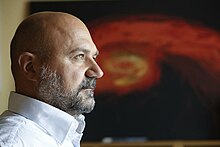Luciano Rezzolla
Luciano Rezzolla (* 1967 in Milan ) is an Italian astrophysicist .
Rezzola studied physics at the universities of Bari and Trieste, was an officer on a submarine of the Italian Navy for a year and then studied further at SISSA in Trieste, where he received his doctorate in 1997 with John C. Miller. As a post-doctoral student he was at the University of Illinois at Urbana-Champaign and then went back to SISSA, where he became a professor. From 2006 he was head of the department of numerical relativity at the Max Planck Institute for Gravitational Physics near Potsdam and has been professor for theoretical astrophysics at the Goethe University in Frankfurt am Main since 2013 . There he is also director of the Institute for Theoretical Physics.
Rezzolla studies compact objects such as black holes and neutron stars within the framework of general relativity and relativistic hydrodynamics and magnetohydrodynamics using analytical and numerical methods. For the comparisons with the observations of the supermassive black hole in M 87 by the Event Horizon Telescope (EHT, the observations from 2017 were presented in April 2019) he undertook computer simulations of the resulting images of the black hole, which were caused by the space-time curvature of the strong gravitational fields of the Black hole are severely distorted. Rezzola not only examines scenarios with black holes, but also with hypothetical structures such as boson stars , wormholes and naked singularities . For example, he ruled out that the observation of gravitational waves from the collision of black holes , published in 2016, could alternatively be described by gravastars . Gravastars are hypothetical bubbles of false vacuum. He also ruled out that the EHT's observation of the black hole in M 86 came from wormholes or naked singularities.
In 2001 he showed that the instability of a neutron star called r-mode results in differential rotation, which strengthens the magnetic field and suppresses the instability. In 2003 he proposed a new model of high-frequency quasi-periodic oscillations (QPO) in the X-ray spectrum of binary systems as the vibrations of the accretion disk of a black hole. In 2011 he and colleagues showed that the fusion of magnetized neutron stars results in a black hole with a magnetized accretion disk, which creates a high-energy jet and provides an explanation for short gamma-ray bursts. In 2013, together with Heino Falcke , he proposed so-called Blitzar s as an explanation of Fast Radio Bursts . A neutron star, which actually has too much mass to be stable ( supramassive ), loses angular momentum and its magnetic field, becomes unstable and collapses into a black hole.
In 2014 Rezzolla received a Synergy Grant from the ERC to study black holes with radio astronomers Heino Falcke and Michael Kramer . He is on the Council (Board) of the Event Horizon Telescope .
He is a passionate sailor.
Fonts
- with Olindo Zanotti: Relativistic Hydrodynamics, Oxford University Press 2013, ISBN 9780198528906
Web links
Individual evidence
- ↑ Cecilia Chirenti, Luciano Rezzolla: Did GW150914 produce a rotating gravastar ?, Physical Review D, Volume 94, 2016, p. 084016. Arxiv
- ↑ Ulf von Rauchhaupt, It's not a naked singularity, Frankfurter Allgemeine Sonntagszeitung, April 14, 2019, p. 57
- ↑ L. Rezzolla, S. Yoshida, TJ Maccarone, O. Zanotti, A new simple model for high-frequency quasi-periodic oscillations in black hole candidates , Monthly Notices of the Royal Astronomical Society, Volume 344, 2003, p. L37– L41, Arxiv
- ↑ Luciano Rezzolla, Bruno Giacomazzo, Luca Baiotti, Jonathan Granot, Chryssa Kouveliotou , Miguel A. Aloy, The missing link: merging neutron stars naturally produce jet-like structures and can power short gamma-ray bursts , Astroph. J., Volume 732, 2011, L 6, Arxiv
- ↑ Falcke, Rezzolli, Fast radio bursts: The last sign of supramassive neutron stars, Astronomy & Astrophysics, Volume 562, 2014, A137, Arxiv
| personal data | |
|---|---|
| SURNAME | Rezzolla, Luciano |
| BRIEF DESCRIPTION | Italian astrophysicist |
| DATE OF BIRTH | 1967 |
| PLACE OF BIRTH | Milan |
